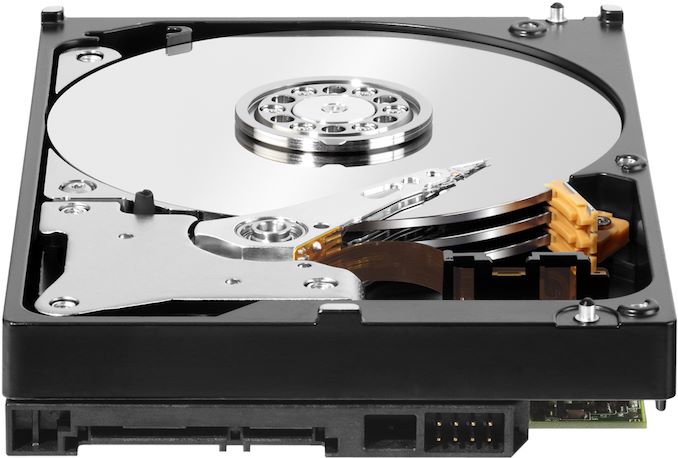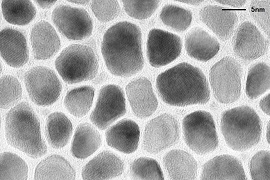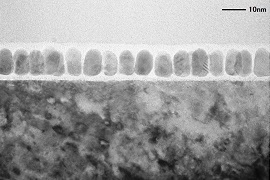The Road to 80 TB HDDs: Showa Denko Develops HAMR Platters for Hard Drives
by Anton Shilov on February 6, 2020 2:30 PM EST- Posted in
- Storage
- Seagate
- Toshiba
- Western Digital
- HAMR
- Showa Denko
- SDK
- HDD

Showa Denko K.K. (SDK) has unveiled the the company has finished the development of its next-generation heat assisted magnetic recording (HAMR) media for hard drives. The platters use all-new magnetic thin films with a very small crystal grain size in order to maximize their areal density, with the goal of eventually enabling 3.5-inch HDDs to be built with capacities of 70 TB to 80 TB.
SDK’s platters for HAMR HDDs use glass substrate and feature thin film magnetic layer made of an Fe-Pt alloy. To improve the magnetic coercivity of the media by several times over existing platters, Showa Denko used a new structure of magnetic layers and implemented new ways of controlling the temperature of the media during production.
UPDATE 2/21: As it turns out, Showa Denko will use glass substrates for platters designed for HAMD hard drives because of their superior heat resistance.
Driving these developments, it's critical to maximize the magnetic coercivity of next generation HDD platters because the crystal grains used to record data are getting extremely small. This has made them very easy to magnetize, but it has also reduced the strength of the individual magnetic signatures, which creates an unwanted magnetic inter-track interference (ITI) effect that makes it harder for HDD heads to read the data. Platters with high magnetic coercivity require energy assistance during writing and this is what energy assisted magnetic recording technologies (HAMR, MAMR, ePMR, etc.) are all about. Meanwhile, the platters must survive extreme temperatures they are subjected to during heat-assisted recording. According to Showa Denko, its new HAMR platters offer the industry’s highest read-write characteristics and durability.
Transmission Electron Microscopy Images of HAMR Media
Plain View Cross Section
SDK is not disclosing the recording density of its new platters nor are they making specific promises about when it intends to start mass production of next-generation disks. Meanwhile, the company notes that today’s leading-edge conventional magnetic recording (CMR) platters feature recording density of about 1.14 Tb/in2 and it is widely believed that this is not going to grow significantly without using energy assisted recording methods. By contrast, Showa Denko believes, HAMR-based media will achieve areal density of 5-6 Tb/in2 in the future, which will increase capacity of hard drives by several times, all the way to 70 TB – 80 TB per 3.5-inch drive without increasing the number of platters. For comparison's sake, today’s 16 TB CMR (PMR+TDMR) HDDs use nine disks, so increasing their density by ~5.2X would enable drives featuring capacities higher than 80 TB.
Showa Denko is the world’s largest independent maker of platters for hard drives, selling media to all of the HDD producers. That said, the large manufacturers — Seagate and Western Digital — also produce media themselves and tend to use their own leading-edge platters to cut costs and maximize product margins. So it will be interesting to see which of three remaining hard drive makers will be the first to use HAMR platters from Showa Denko.
Seagate will be the first company to adopt HAMR for commercial 20 TB drives in late 2020, but since Showa Denko now only plans to ‘make preparations for full-scale supply of the new HD media’, it is likely that the first HAMR drives will use Seagate’s own platters. Toshiba is expected to use Showa Denko’s 2 TB MAMR platters for its 18 TB HDDs that are projected to arrive later this year, but in the longer terms it will switch to HAMR (we have no idea when). By contrast, Western Digital uses its so-called energy-assisted PMR (ePMR) technology for its 18 TB and 20 TB HDDs due this year and will gradually move to MAMR and HAMR in the years to come.
Related Reading:
- Toshiba's HDD Tech Roadmap: A Mix of SMR, MAMR, TDMR, and HAMR
- 18 TB HDDs: Toshiba Collaborates with Showa Denko for MAMR HDDs
- HOYA Starts to Build Next-Gen HDD Glass Substrate Production Facility
- Seagate: 18 TB HDD Due in First Half 2020, 20 TB Drive to Ship in Late 2020
- Western Digital Roadmap Updates: Energy Assisted Recording, Multi-Stage Actuators, Zoned Storage
Source: Showa Denko












75 Comments
View All Comments
cosmotic - Thursday, February 6, 2020 - link
Any increase in the speed of the data transfers? Is it time to add more read/write heads? Seems the stackexchange answer is out of date and nothing in the answer precludes implementation https://superuser.com/questions/1137805/why-arent-...shabby - Thursday, February 6, 2020 - link
They'll hit 80tb as soon as intel hits 10ghz on the p4...waterdog - Thursday, February 6, 2020 - link
Photo caption: "Plan View" not "Plain View" though the surface is likely pretty darn flat.GCappio - Thursday, February 6, 2020 - link
For my degree in 1993 I have been working for 2 years in a physics university lab (Politecnico for Engineers, I am an electronic engineer, branch "microelectronics, optoelectronics, instrumentation") in Milan, Italy on "Thin Fe (Iron) films grown on Ag(100) (crystalline silver) studied by angle- and spin-resolved inverse-photoemission spectroscopy"...So, we discovered that the magnetic domains are perpendicular to the surface for Iron films up to 5 atomic layers, then the magnetic domains become parallel to the surface if there are more than 5 atomic layers...
This means that if you are able to make platters with up to five Iron atomic layers, then you can have muche denser bit recording per square inch... I wonder if they will ever be able to make such platters, and what would the recording density...
See this article... https://journals.aps.org/prb/abstract/10.1103/Phys...
rahvin - Thursday, February 6, 2020 - link
Is the platinum new? I don't remember Platinum being a platter ingredient. I hope it's a really tiny amount cause yikes that's going to boost drive prices.eldakka - Thursday, February 6, 2020 - link
I don't think even 20TB HDD are practical at the currently available data transfer rates, let alone 80TB.At least not in RAID (e.g. ZFS raidz2 or raidz3) arrays as other commentators have noted. I have 8TB HDDs in raidz2, and if I lose a disk, it takes the best part of a day to resilver the replacement drive.
Adding a second actuator with a second set of heads would help tremendously. However, the cost of this (assuming they could even fit them in) would probably bring them up to near SSD prices anyway ...
Brane2 - Friday, February 7, 2020 - link
That's where multihead access and redundance comes in.With multihead transfers and 8 platters you get 16x transfer speed.
With extra head per platter you get considerable redundance.
One such 20 TB drive could be much more reliable thatn a coresponding bunch of classic HDDs in RAID-6 for example.
GreenReaper - Friday, February 7, 2020 - link
Extra heads per platter sound like more things to break inside an enclosed space, and more heat. Neither seem particularly good for reliability.Brane2 - Friday, February 7, 2020 - link
Heat issue was adressed with helium.More things can go wrong, but if they do, user will be given the options that s/he had not have before. Like to use other good head for data migration from affected plater side.
Also, with such high capacity drives users will expect to pay some more $$$ foor better mechanics as these things will be used for cold storage. Which means better bearing materials, much more detailed SMART, better head mechanics and abillity to run normally 24/7 in degraded mode ( like with 1 faulty head) etc.
extide - Friday, February 7, 2020 - link
More IOPs, not more bandwidth.